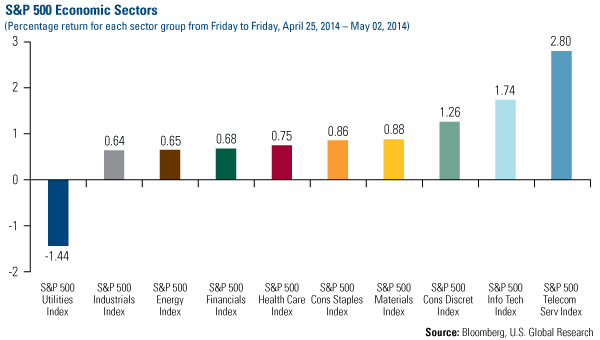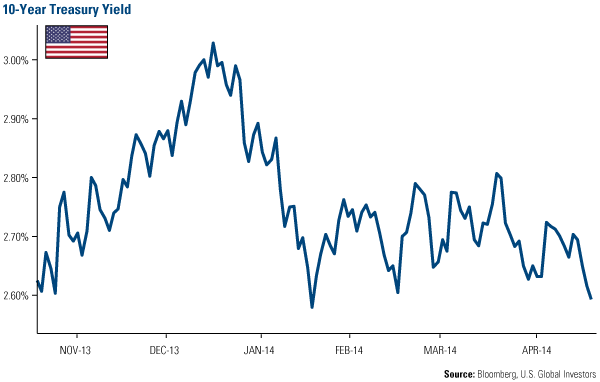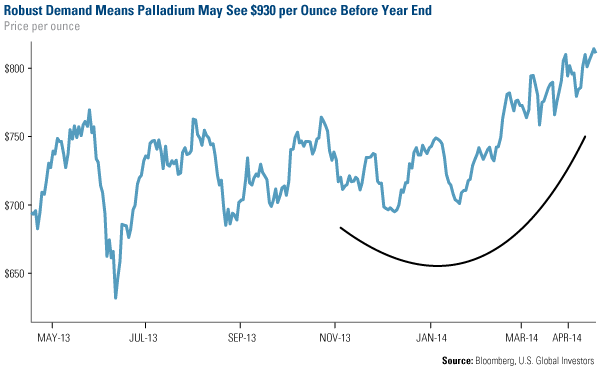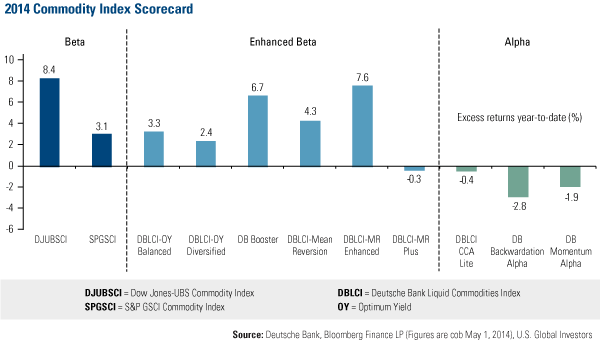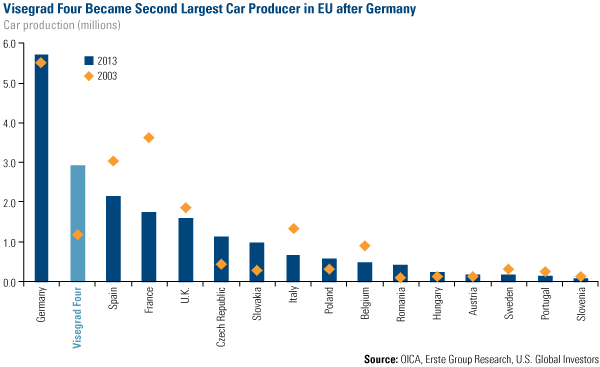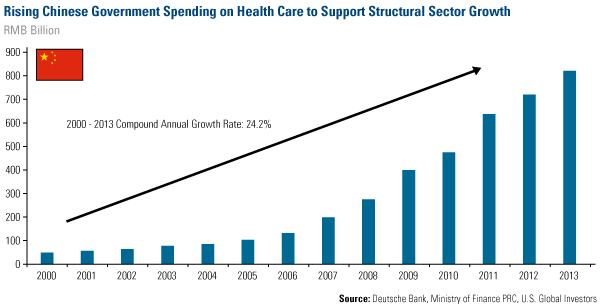Albania’s Fertile Grounds for Oil Opportunities
May 4th, 2014
by Frank Holmes
of U.S. Global Investors
Texas is oil country. The state I now call home leads the nation in oil production and would be one of the top oil-producing nations if it were its own country. But that doesn’t stop us from exploring other promising oil opportunities further afield. Last week I traveled to Albania to check out a drill site of Petromanas Energy, a Calgary-based international oil and gas company focused on exploration and production throughout Europe and Australia. We own the junior stock in our Global Resources Fund (PSPFX) and Emerging Europe Fund (EUROX).
 |
To many, Albania is an unknown country yet it has a rich and interesting history. It declared independence from the Ottoman Empire in 1912, was conquered by Italy in 1939 and occupied by Germany in 1943. Albania allied itself with the USSR until 1960 and then with China until 1978. Democratic development has progressed since the country’s first multiparty elections in 1991. The 2009 general elections resulted in the country’s first coalition government and the 2013 election saw a peaceful transition of power. A parliamentary democracy, the country has steadily been welcoming foreign direct investment (FDI) since it shifted away from communism in the early 90s. The recent FDI into the country comes on the back of the extensive development of its rich petroleum resources.
Third Time’s a Charm
This was my third trip to Albania. I last visited the country in 2004 when we were seed investors in another oil play there, Bankers Petroleum. Today Bankers’ Albanian discovery is the largest onshore oilfield in all of Europe. The company is now close to 40 percent of Albania’s FDI and is reinvesting all cash flow back into the country, about $300 million per year. Bankers has done an amazing job cleaning up the environmental disaster left behind by previous operators of the assets which Bankers is developing. Today the fields are green and sheep roam freely. Old and dirty early rigs have been replaced with new safer, cleaner technology.
So much has changed since my last visit. The country is more prosperous and more verdant. Capital city Tirana’s infrastructure and roads have improved by a quantum leap in the past 10 years. Every morning I ran in Rinia Park, the large central public park, with Marin Katusa of Casey Research. We were impressed with the hundreds of locals jogging at 7 a.m.
Meeting A Man of Many Colors
 |
On this visit I was honored to meet the Prime Minister of the country since 2013, Edi Rama, who also served as the mayor of Tirana from 2000 to 2011. He is a fascinating leader. Rama is a native of Tirana and, in addition to becoming involved with the first democratic movements in Albania, he is an artist and a former basketball player for the Albanian national team. He is, to a large degree, responsible for the vibrancy I saw in Tirana, his Clean and Green project resulting in nearly 100,000 square meters of green land and parks, and his creative efforts to use art and color helping to curb corruption and revive civic pride and responsibility. You’d enjoy watching him explain this dramatic transformation in his TED talk Take Back Your City with Paint. Rama has helped form a stable political environment in Albania, just one reason Petromanas Energy has invested in drill sites here.
Fertile Ground for Oil and Gas
The company’s assets in Albania cover more than 1.1 million gross acres. In the company’s presentation during our visit, management explained why Albania’s landscape is also key. Petromanas is exploring for large, deep, fractured carbonate structures of Eocene-Cretaceous age, similar to those in southern Italy which are the sites of several prolific oil fields.
click to enlarge
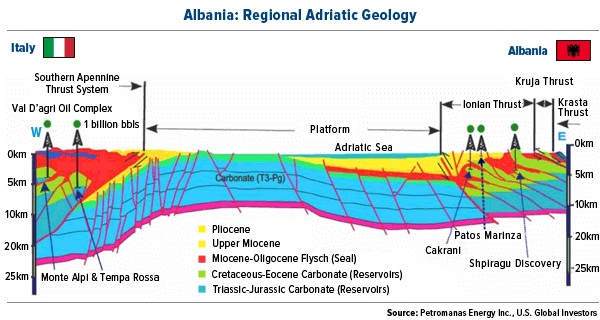
Located across the country’s Berati thrust belt, you can see the multiple wells in the map below: Papri, Shirag and Molisht. Petromanas is looking for a light oil deposit in these wells. Super major Royal Dutch Shell has invested $200 million to partner in these plays.
While at Petromanas properties, our group saw a few of these wells, but most notable was the visit to the Molisht-1 well that is currently being drilled. As Keith Schaefer points out in his recent Oil and Gas Investments Bulletin on the Albania trip, the Molisht-1 well has the potential to be an 8,000-10,000 barrels of oil production per day well, an absolute company maker. And according to Petromanas’ presentation, the Molisht-1 well could potentially hit earlier than expected, which would be a positive surprise for the company.
What do the founder of Lionsgate Entertainment and a former NATO Commander have in common?
|
|
Petromanas Energy is an example of a company that is currently in a strong area of the market and exhibits robust fundamentals. Its management, research and location are only a few reasons I see great potential for this organization. Escorting us on the research trip were two of the company’s directors, my good friend the legendary Canadian venture capitalist and philanthropist extraordinaire Frank Giustra, and General Wesley Clark, who as the former Supreme Allied Commander Europe, led the charge to stop Serbian forces from committing genocide in Kosovo. I’ve also had the privilege of working alongside these distinguished gentlemen with the International Crisis Group, a non-profit, non-governmental organization committed to preventing and resolving deadly conflict around the world.
The Path from War to Peace and Prosperity in 20 Years
Albanians and their Balkan neighbors have seen more than their share of conflict. The trigger for World War I was the assassination in Sarajevo of Archduke Ferdinand, heir to the throne of Austria-Hungary, by a Yugoslav nationalist in 1914. The Yugoslav Wars fought from 1991 to 1999 on the territory of former Yugoslavia have been described as Europe’s deadliest conflict since World War II and the first since the Great War to be formally judged genocidal. It is estimated at least 130,000 lost their lives. In the last of these ethnic conflicts, the Kosovo War, a million ethnic Albanians fled or were forcefully driven from Kosovo by Yugoslav troops. Under the command of General Clark, NATO forces bombed Serbian forces to prevent the continued displacement and persecution of the Albanian people.
 |
Prime Minister Rama told us that he is profoundly grateful to the American people, President Clinton, and NATO for saving the lives of at least 900,000 Albanians and ushering in stability and positioning the region for progress. It was a case study in the successful use of force to bring peace to a region and a consequent drive for prosperity for its people. Our collective investment in this humanitarian success story is paying dividends for a new generation of Albanians. The country’s transition to a free market economy has been difficult and there are many economic challenges on the road ahead but the government believes in creating a path favorable for business. Companies such as Bankers Petroleum and Petromanas are helping Albania to develop its natural resources, improve its economy and create growth opportunities for investors who see the potential of this resilient country.
Index Summary
- Major market indices finished higher this week. The Dow Jones Industrial Average gained 0.93 percent. The S&P 500 Stock Index rose 0.95 percent, while the Nasdaq Composite advanced 1.19 percent. The Russell 2000 small capitalization index rose 0.51 percent this week.
- The Hang Seng Composite fell 0.38 percent; Taiwan gained 1.06 percent while the KOSPI declined 0.62 percent.
- The 10-year Treasury bond yield fell 8 basis points to finish the week at 2.59 percent.
Domestic Equity Market
The S&P 500 Index rose this week on good earnings results, merger and acquisition (M&A) activity and better economic data. The market remains resilient with the S&P 500 less than one percent away from recent highs, and earnings reports have generally been well received.
click to enlarge
Strengths
- The telecommunication services sector was the best performer this week as AT&T rose by more than 3 percent and Verizon Communications rose by 2.5 percent. Sprint reported quarterly earnings that were well received by the market, AT&T announced it was in talks with DirecTV, and bond yields rallied, which tends to benefit dividend-paying stocks such as telecommunication companies.
- The technology sector continued to advance this week with index heavyweights Apple, MasterCard and Facebook all rising at least 3 percent. Apple saw continued momentum from last week’s earnings results, MasterCard’s earnings release was well received this week and Facebook hosted a developer’s conference with an emphasis on mobile ads that was also well received.
- Electric utility Pepco Holdings Inc. was the best performer in the S&P 500, rising 23.5 percent this week on the heels of the take-over offer from Exelon Corp.
Weaknesses
- The utility sector was the worst performer this week in spite of lower bond yields and M&A activity. The group has had a very strong run over the past few months and a pause would not be surprising.
- Some industries exhibiting weakness this week include tires and rubber, gold and health care services.
- Coach was the worst performer in the S&P 500, falling 12 percent. The company announced disappointing quarterly results as quarterly same-store sales in North America fell 21 percent. Overall, revenues fell 7.4 percent year-over-year.
Opportunities
- The current macro environment remains positive as economic data remains robust enough to give investors confidence in an economic recovery but not too strong as to force the Federal Reserve to aggressively change course in the near term.
- The selloff in high-quality companies offers an opportunity to pick up companies with robust fundamentals at attractive prices.
- Quarterly earnings reports continue to be well received by the market and companies are beating expectations.
Threats
- A short-term market consolidation period after such strong performance cannot be ruled out.
- Higher interest rates are a threat for the whole economy. The Fed must walk a fine line and the potential for policy error is large.
May 1, 2014Is Real GDP the Key Catalyst for Gold Demand? |
May 1, 2014In Greece, Pay Attention to Banks and the Bond Sale |
April 29, 2014Where Is All the Gold Headed? |
The Economy and Bond Market
Treasury bond yields declined again this week, pushing the benchmark 10-year yield to established support levels near 2.60 percent. Economic data was mixed but on balance, there were more positives than negatives. Geopolitical events appear to be a driver as unrest between Russia and Ukraine intensifies and investors prefer the safety of U.S. Treasuries. The Fed met expectations this week with another round of tapering of quantitative easing (QE) and no surprises in the official press release.
click to enlarge
Strengths
- Nonfarm payrolls grew 288,000 in April. This was ahead of expectations and was a very strong report that should bolster investors’ confidence in a strengthening recovery.
- The ISM’s April manufacturing index rose to 54.9, indicating a healthy manufacturing sector and rebounding nicely from a weather-induced slowdown a few months ago.
- The American Institute for Economic Research’s Business-Cycle Condition report improved in April and is one more leading indicator pointing toward continued economic recovery.
Weaknesses
- The Conference Board’s consumer confidence index declined slightly in April after hitting a six-year high in March.
- The S&P/Case-Shiller 20 city home price index declined sequentially in March.
- Chinese president Xi Jinping reaffirmed China’s intent to leave fiscal and monetary policies unchanged. Investors remain concerned that China could slow in 2014, affecting the global economy.
Opportunities
- The Fed has reiterated its intention to not raise interest rates before economic data supports that decision, not based on a timeline.
- The President of the European Central Bank (ECB), Mario Draghi suggested the ECB may ease monetary policy in response to the strong euro.
- There are many moving parts to the taper decision and while the Fed began the process, it is very possible that tapering could be delayed if the economy stumbles.
Threats
- In addition to the inherent difficulties in exiting the QE program and the potential for a misstep, there is also the potential for miscommunication from the Fed with the recent change in Fed leadership.
- Trade and/or currency “wars” cannot be ruled out which may cause unintended consequences and volatility in the financial markets.
- China remains a wildcard for economic recovery and the economy has shown some cracks in recent months. This is similar to how last year started and China found its footing. Something similar needs to happen this time around.
World Precious Minerals Fund – UNWPX • Gold and Precious Metals Fund – USERX
Gold Market
For the week, spot gold closed at $1,300.62, down $2.58 per ounce, or 0.20 percent. Gold stocks, as measured by the NYSE Arca Gold Miners Index, declined 0.38 percent. The U.S. Trade-Weighted Dollar Index fell 0.28 percent for the week.
Strengths
- Gold jewelers in India, the world’s second-largest consumer, are expecting a surge in demand at the country’s bullion buying festival this week. The anticipation for the Akshaya Tritiya festival, which is considered by the nation’s more than 900 million Hindus as an auspicious day to buy precious metals, has driven jewelers to buy gold from importing banks at premiums as high as $110 per ounce over the London fix price.
- Global demand for silver jewelry exports from India soared 59 percent over the past year as industry officials expect further growth in exports this year. Trade organization officials expect exports to rise in the 2014-15 season as jewelers try to meet rapidly rising demand from China, Russia, and the U.S. The CPM group, a commodities consultant, has reported silver demand for jewelry rose to 266.5 million ounces in 2013, the highest level in at least 10 years, increasing its share of the declining global supply of silver, which only reached 971 million ounces in 2013.
- Klondex Mines announced the results of the PEA on its Fire Creek project. Despite the very conservative assumptions underlying the report, the PEA shows an initial mine plan with immediate positive cash flows. The company noted the IRR could not be calculated because the cash flow is positive in the first year and every succeeding year after that. In a similar note, NGEx Resources reported results from drill holes which confirm the continuity of the high-grade copper and silver mineralization at its Filo del Sol project in Argentina. The drill holes reported grades as high as 7.59 percent copper, and 314.5 grams per tonne silver over 12 meters.
Weaknesses
- Gold fell $2.58 per ounce for the week, as positive data in the U.S. lowered demand for the precious metal. The Fed meeting appeared to be a non-event as the cut of an additional $10 billion in asset buying matched economists’ predictions. Hong Kong gold exports to China offered a relief, as net imports reached 80.6 tonnes in March, down from 111.4 tons in February. Silver, which fell 0.99 percent for the week, is being undermined by its association with gold despite nine-year-high buying by makers of jewelry and solar panels.
- A U.S. Senate Special Committee on Aging staff report “conservatively estimates that more than 10,000 Americans have been victimized through [precious metals] schemes, with losses around $300 million.” Seniors, looking for a safe haven for their life savings, have been led into buying leveraged gold, silver, platinum, or palladium bets under the impression that they are participating in safe investments. The sellers scam seniors with multiple fees and interest costs that benefit scammers, while leaving the seniors’ principal to bear all the risk of the leveraged bets.
- Election violence has flared in South Africa’s platinum belt ahead of the elections, according to a Reuters report. Police used water cannon and stun grenades to disperse rioters in South Africa’s strike-hit platinum belt on Sunday after protesters, allegedly affiliated to the ACMU union, attacked a government minister while campaigning for the May 7 election. The ACMU’s 70,000 members remain off the job after wage talks aimed at ending the 13-week long strike collapsed.
Opportunities
- The latest Platinum and Palladium Survey by GFMS, the leading independent precious metals consultancy, shows the impact on platinum by South African strikes has been muted; however, palladium has begun to move strongly. The highly successful launch of two South African palladium ETFs, together with supply constraints arising from the events between Russia and Ukraine are further emphasizing the market deficit for the precious metal. As such, GFMS believes palladium has bottomed out already and expects the robust fundamentals to propel the price towards a test of $930 per ounce before year-end.
click to enlarge
- Agnico Eagle Mines reported record first-quarter gold production which prompted the miner to forecast it will surpass the high end of 2014 production guidance, with costs expected to come below the low end of the original forecast range. Northern Star Resources, the Australian producer that agreed to buy assets from Barrick Gold, announced it is seeking further acquisitions amid a “once-in-a-generational change in ownership in the Australian gold space.” Desjardins Capital Markets initiated coverage of MAG Silver Corp. with a Buy-Speculative rating and a C$10 price target.
- Randgold Resources will start a study of Kenya’s gold-mining potential at the end of this month to help the government assess whether it is viable to mine gold in the country. According to the African Development Bank, Kenya has known gold deposits, yet mining represents less than 1 percent of GDP. In a similar move, Mark Bristow, Randgold’s CEO, praised the Ivory Coast government in coming up with a new mining code which, in his view, addressed the needs of investors while remaining potentially hugely beneficial to the African nation’s economy.
Threats
- ABN-AMRO, the largest Dutch bank by assets, revised its gold forecast price down to $1,235 per ounce as it expects the U.S. economy to accelerate, and U.S. yields and the U.S. dollar to move higher. The bank released its outlook to coincide with the Fed’s announcement of a further $10 billion monthly taper. Important macroeconomic indicators to follow next week are U.S. Non-Manufacturing ISM, Chinese CPI and PPI data, and the Japanese Leading Index, which is expected to show further deceleration.
- Morgan Stanley bank analysts almost “outbear” Goldman Sachs analysts on gold price, according to Mineweb’s Lawrence Williams. Morgan Stanley’s analysts suggest gold will trade down to $1,168 in the second half of the year, and will continue trending down to $1,138 in 2015. The main driver, according to the analysts, is the fall-off in Chinese demand caused by a weakening economy and depreciating currency. However, Chinese gold import demand has continued to show resiliency, even as the currency depreciation makes gold more expensive in local terms. February and March import data from Hong Kong show imports of over 190 tonnes, roughly in line with the pace of imports in the fourth quarter of 2013.
- Barrick Gold shareholders were in for a major disappointment on Wednesday at the company’s annual general meeting. The announcement of a 90 percent plunge in Barrick’s profits from last year was eclipsed by Peter Munk, the unpopular retiring chairman of the board, who gave a rude awakening to hopeful shareholders in announcing that he intends to remain “very involved in Barrick” and that he will retain an office at the company’s corporate headquarters in Toronto.
Energy and Natural Resources Market
click to enlarge
Strengths
- Commodities outperformed equities and bonds in first quarter of 2014, taking the pole position among major asset classes for the first time since the first half of 2008.
- The CRU weekly steel price assessment shows US HRC at $683 per short ton, up $4 from the prior week ending 4/30, its fifth-consecutive weekly rise. Also, the quarter-to-date average is $671 per ton. This compares to first- and fourth-quarter averages of $650/st and $661/st, respectively.
- Copper futures rose the most in five weeks as global stockpiles drop to the lowest level in five years according to data compiled by Bloomberg.
Weaknesses
- Iron ore prices plunged to a seven-week low as China’s banking regulator urged a probe on iron-ore financing deals, in a bid to minimize default risks, prompting a sell-off. Platts assessed 62% Fe Iron Ore Index fell to $108.25/dry mt on April 28, the lowest since March 13.
- Aluminum Corp. of China Ltd., the nation’s biggest producer of the lightweight metal, said its first-quarter loss widened as industry overcapacity caused prices to fall. The Beijing-based company posted a loss of 2.2 billion yuan ($352 million), or 0.16 yuan a share, in the three months ended March 31, from 975 million yuan, or 0.07 yuan a share, a year ago, it said in a statement to the Shanghai Stock Exchange.
- Homeownership in the United States fell in the first quarter to its lowest in more than 18 years, suggesting it will take a while for housing to heal from the recession’s deep scars. The seasonally adjusted homeownership rate, the share of households owning a home, slipped to 65 percent. That was the lowest since the third quarter of 1995.
Opportunities
- GFMS, the precious metals research group owned by Thomson Reuters, launched its 2014 Platinum & Palladium survey. The group forecast in 2014 the platinum market would be in a physical deficit of 0.7 Moz and the palladium market a deficit of 1.3 Moz. The research group stated that even if the strike that has crippled South African PGM production ends in the next few weeks, it would be some time before the mines were operating again, transforming the current loss of about 0.6 Moz of platinum output into a total loss of near 1 Moz (with palladium losses about 50 percent of this). As a result, GFMS saw the platinum price trading as high as $1,700/oz and palladium testing $930/oz in the second half of 2014.
- China’s aluminum industry is in search of a new bauxite source following the Indonesian ore export ban (65 percent of total China’s bauxite imports), according to Wood Mackenzie. China’s alumina refinery production is forecasted to grow by approximately 17m tonnes by 2018, and a further 40m t by 2030 requiring additional 130m t of bauxite over 2013 levels and as much as 240m t by 2030.
- U.S. LNG export approvals may total 18.53 billion cubic feet a day (bcfpd) if the existing pipeline of projects are approved. Current approvals stand at 9.3 bcfpd and may double if all projects that have also sought Federal Energy Regulatory Commission approval are signed off by the Energy Department. LNG exports are expected to start in late 2015 when Cheniere Energy’s Sabine Pass is expected to reach completion. U.S natural gas production is forecast to average 69.5 bcfpd in 2015, according to the EIA.
Threats
- Growing tension surrounds Russia and Ukraine, with no sign of a resolution to the current crisis. U.S. President Barack Obama announced new sanctions against Russia, including expanding the list of people whose assets will be frozen and who will be denied travel visas to both the U.S. and EU. These sanctions do not seem very tough at all.
- China’s GDP is likely to grow 7.3 percent in 2014, according to the median forecast in a poll of 34 economists, a reading that is lower than 7.7 percent in 2013 and could mark the weakest showing in 24 years.
China Region Fund – USCOX • Emerging Europe Fund – EUROX
Emerging Markets
Strengths
click to enlarge
- European Union (EU) membership has expanded the export opportunities for Eastern European countries, with the highest contribution to export growth in these countries coming from exports to old member states. This unique opportunity allowed for companies in Western Europe to build new or scale up existing production capacities in the Eastern Europe EU member countries. Car manufacturing became the most prominent export oriented industry in the four Central European countries of Czech Republic, Hungary, Poland, and Slovakia, known as the Visegrad Four, or V4. These countries have been persistently outperforming car production in old member states and, as a group, have become the second largest car producer in EU, after Germany.
- Fitch Ratings changed the outlook on Slovenia’s credit rating to stable from negative, saying the economy is recovering faster than expected. According to Fitch, “the government’s policy actions in late 2013 and early 2014 have materially reduced risks surrounding the banking sector, and thus the sovereign balance sheet.” The government actions over the past 12 months helped the Adriatic nation avoid a bailout last year by repairing the banking industry, initiating the sale of state-owned companies and pledging to reduce a budget gap that ballooned to 15 percent of output.
- Indonesia’s trade balance remained in surplus for a second straight month in March at $673 million, higher than consensus estimates. Headline inflation continued to moderate to 7.25 percent year-over-year in April, thanks to easing food inflation.
Weaknesses
- Brazilian President Dilma Rousseff has presided over more corporate bond defaults in Brazil than any of her predecessors. Last week, auto parts maker Sifco halted payments on its dollar-denominated bonds, pushing the amount of defaulted debt to $8 billion during Rousseff’s presidency. That represents more than double the amount during the two-term presidencies of predecessors Luiz Inacio da Silva and Fernando Henrique Cardoso. Rousseff’s inability to revive growth in Latin America’s biggest economy and tame inflation that has exceeded Brazil’s target since she took office helps explain some of the 11 defaults during her tenure, said Sterne, Agee & Leach Inc.
- Poland’s manufacturing sector expansion slowed in April as output and new orders dragged the purchasing managers’ index to its lowest level in nine months, according to HSBC. The survey of 300 industrial companies showed the manufacturing PMI dropped to 52 points in April from 54 points in March, below expectations of a 54 reading.
- The Chinese renminbi weakened by 3.3 percent year to date, the worst performing Asian currency, driven by Chinese central bank’s resolve to reform and growing fears of more defaults from high yielding wealth management products.
Opportunities
click to enlarge
- A recent correction in Chinese healthcare equities has brought sector valuation to a more reasonable level relative to projected growth. Structural drivers remain unchanged including aging population, worsening pollution, unhealthy lifestyles, and, more importantly, rapidly increasing government spending on healthcare which grew 24 percent per year in the last 14 years.
- India’s Finance Ministry will propose tax code changes to help the next government spur foreign currency inflows, according to Bloomberg. Among the proposals is a plan to remove the capital gains tax for short-term stock investments while marginally raising the securities transaction tax, the officials said. The government also would be asked to consider an amnesty program to lure back funds parked outside the country without paying Indian taxes. With the reform, India seeks to restore its confidence among global investors and provide a greater degree of stability for capital investment.
- Turkish central bank Governor Erdem Basci sparked a rally in Turkish stocks when he announced that he may cut borrowing costs should the recent decline in the country’s risk premium stick and the inflation outlook improves. The central bank has been under pressure from Prime Minister Recep Tayyip Erdogan to cut rates after unexpectedly raising them in January to halt a slide in the lira. Basci, who has reiterated the central bank’s independence, said any change of monetary policy would reflect a decline in Turkey’s sovereign risk premium.
Threats
- Brazil’s government announced the lowest first quarter primary fiscal surplus in 4 years, reporting a surplus equivalent to 1.75 percent of GDP, below the 1.9 percent target for 2014. The fiscal budget is expected to come under pressure in the second and third quarters as President Rousseff announced a reduction in individual income taxes and an increase in transfer payments ahead of the October presidential election.
- Russian bonds fell, sending yields to a seven-week high, and the ruble weakened on concern President Vladimir Putin will send troops into Ukraine after the government in Kiev engaged pro-Russian forces, defying Putin’s demand to pull back troops. The situation in Ukraine today is the beginning of a further escalation and the risk of an invasion is bigger than that priced by the market, according to Lars Christensen, chief emerging market analyst at Danske Bank. Christensen added that the expectation is for the situation to get worse before it gets better.
- Volatility in Hong Kong-traded Chinese equities may increase going forward because of the overhang associated with potentially rising debt defaults with the maturity schedule for wealth management products peaking in the second half of this year and no consistent government policy solutions in sight.







